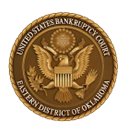NOTICE FROM THE UNTIED STATES BANKRUPTCY COURT FOR THE EASTERN DISTRICT OF OKLAHOMA REGARDING:
JUDGE MICHAEL’S POLICY REGARDING
GRANTING RELIEF FROM BANKRUPTCY RULE 4001(a)(3)
(September 3, 2021 for the Eastern District of Oklahoma)
This Court will not grant relief from the 14-day stay of execution on an order modifying the automatic stay as is provided for in Federal Rule of Bankruptcy Procedure 4001(a)(3) as a matter of course. After careful consideration, this Court has concluded that granting this relief as a matter of routine, particularly in cases where stay relief has been unopposed and is being granted by default, risks working considerable hardship on debtors, and particularly consumers, by effectively mooting any post-order remedies or relief they might seek. Rule 4001(a)(3) grants the Court wide discretion in shortening or eliminating the fourteen-day stay upon proper request. The Court believes this discretion is rendered meaningless if the relief is routinely granted.
We have had a recent run on requests for relief from the 14-day stay of execution. The most common bases for these requests are allegations that the debtor is in default on the underlying obligation, the value of the collateral is less than the amount owed, and the collateral is not insured or no proof of insurance has been shown. Let’s think about these for a minute. If pre-petition default on an obligation or the mere fact that a creditor is under secured meant that the 14-day stay of execution should be waived, there would be no reason for the rule to exist. These exceptions would swallow the rule. On the issue of lack of insurance, some degree of inquiry is required. Telling me “the debtor has failed to provide proof of insurance” means nothing unless you have actually asked the debtor to provide proof of insurance.
Some creditors claim that their collateral is “rapidly declining in value.” If you make that allegation, be prepared to prove it. Recently, a creditor asserted that a seven-year-old motor vehicle with over 100,000 miles on it was “rapidly declining in value.” Seriously? Folks, when we are talking about depreciation on a seven-year-old car with a spun odometer, unless someone is dangling that car above a crusher, that ship has already sailed. Most seven-year-old cars don’t do anything rapidly.
Parties seeking to shorten or eliminate the fourteen-day stay pursuant to Rule 4001(a)(3) must include in both their motion and proposed order a concise statement of the factual basis for shortening or eliminating the stay in order to have such a request considered. Our local rules also require that the motion include a statement that the movant seeks relief from the 14-day stay of execution provided for in Rule 4001(a)(3) in the title of the motion. Local Rule 4001-1(B)(3). If any of these requirements are not met, the request for relief from the fourteen-day stay of execution will be summarily denied. In the alternative, the Court will grant relief from the 14-day stay of execution provided for in Rule 4001(a)(3) where such relief is included in a proposed order that has been approved as to form and content by the debtors and, in a Chapter 7 case, any trustee (a/k/a an “agreed order”).
If your client wishes to escape the 14-day stay mandated by the Federal Rules of Bankruptcy Procedure, you need to plead a real harm that will befall that client if the order granting relief is stayed. And, if you plead it, know that you could be asked to come into court and prove it. Leave the boilerplate at home. Thanks.
